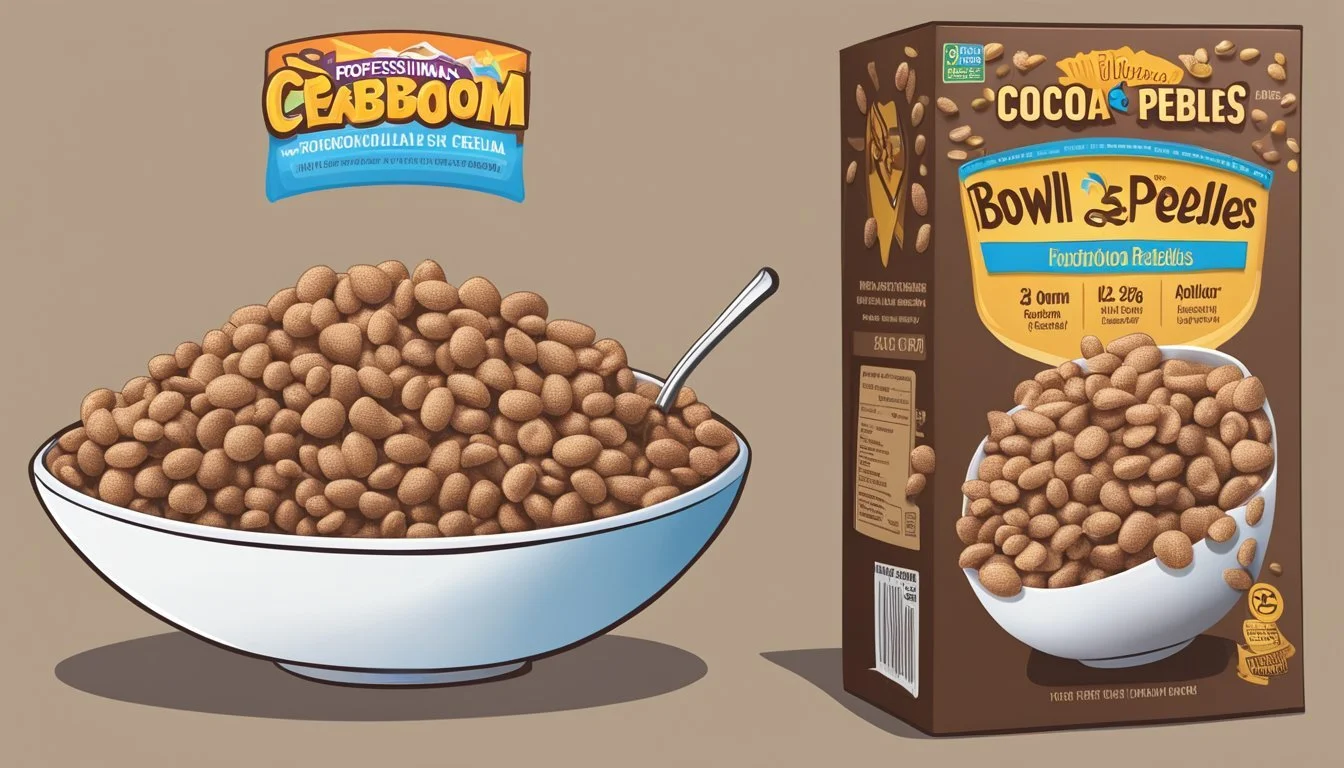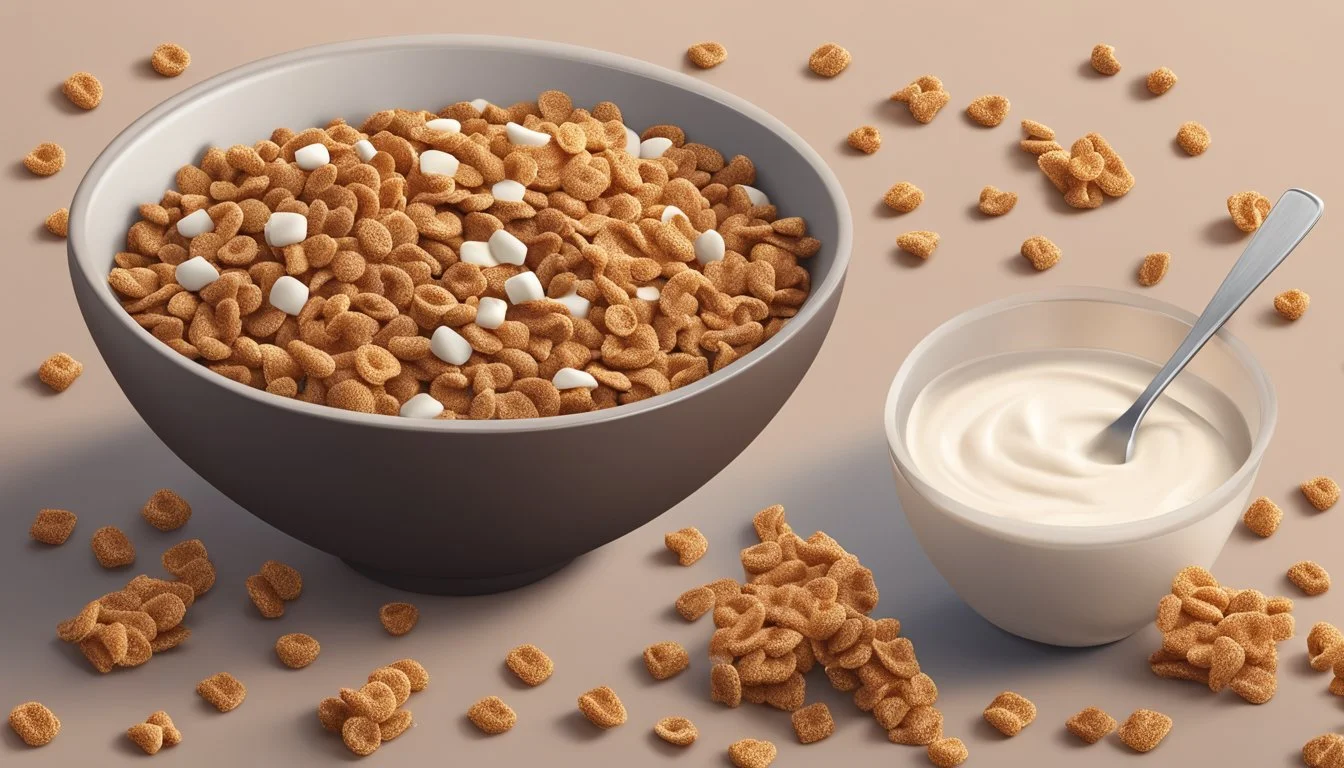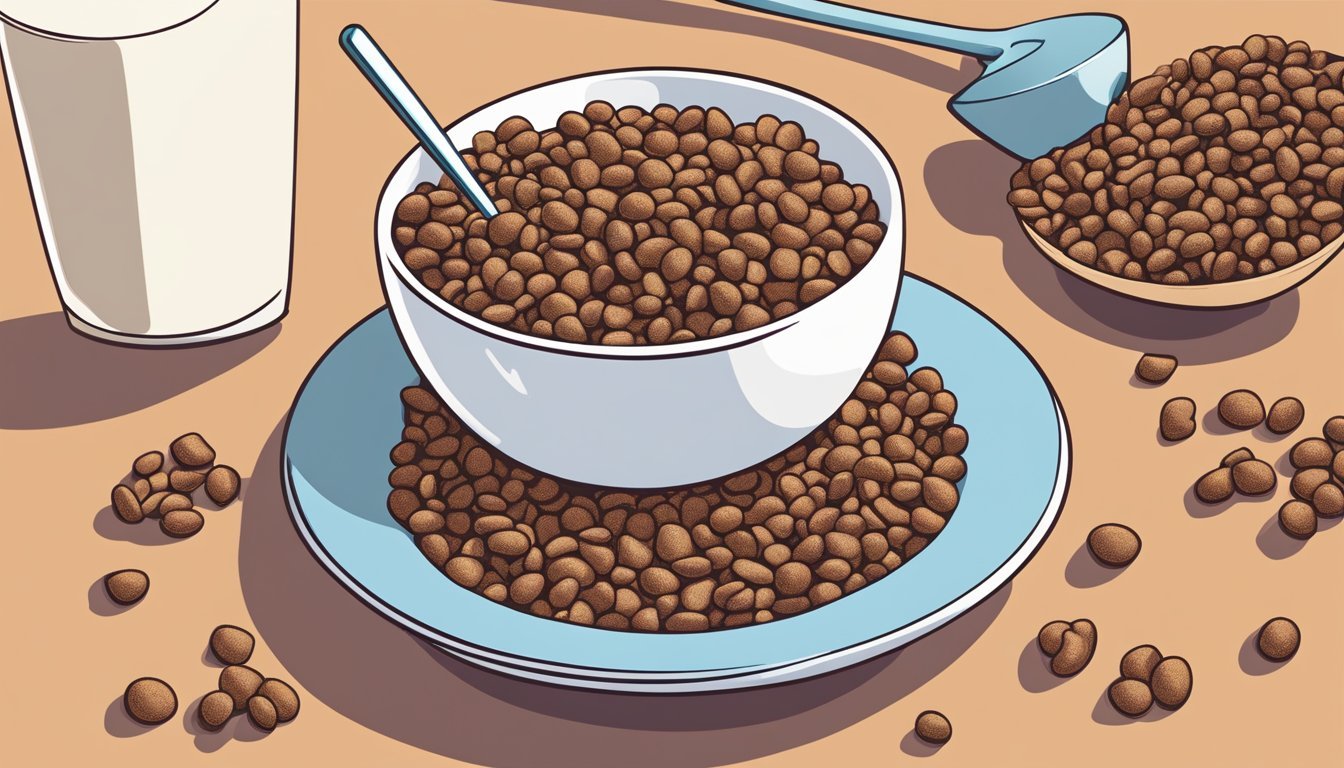Cocoa Pebbles vs Kaboom
Comparing Iconic Breakfast Cereals
This Article is Part of Our Breakfast Cereal Guide with Details on Cocoa Pebbles Nutrition and Kaboom Nutrition
When it comes to breakfast cereals, Cocoa Pebbles and Kaboom stand out for their unique flavors and textures. Cocoa Pebbles, produced by Post Consumer Brands, offers a chocolatey, crispy experience that has captivated cereal enthusiasts since its introduction. It's widely appreciated for its rich cocoa taste and the way it turns milk into a delightful chocolate beverage.
Kaboom, on the other hand, presents a different but equally intriguing option. Known for its vibrant colors and marshmallow surprises, Kaboom brings an element of fun to the breakfast table. It combines the crunch of cereal with the sweet, playful notes of marshmallows, making it a hit among younger audiences and those who enjoy a more whimsical start to their day.
For those comparing the two, the choice often boils down to a preference between chocolatey richness and colorful sweetness. Each cereal offers a distinct eating experience that caters to different taste preferences and nostalgia.
History and Origin
Cocoa Pebbles and Kaboom Cereal each have unique histories marked by notable developments and iconic affiliations. Their creation and evolution reflect broader trends in the cereal industry.
Creation of Cocoa Pebbles
Cocoa Pebbles was introduced in the United States by Post Consumer Brands on October 20, 1971. The cereal features chocolate-flavored, crispy rice bits.
It was part of a strategic move to leverage popular culture, specifically The Flintstones animated series by Hanna-Barbera. Using characters like Fred Flintstone as brand ambassadors, Cocoa Pebbles quickly gained popularity.
This cereal stands out for its branding, being one of the first to be based on existing cartoon characters. The combination of its unique chocolate flavor and association with The Flintstones ensured its place in breakfast lore.
Development of Kaboom Cereal
Kaboom Cereal, released by General Mills in 1969, was known for its colorful, ring-shaped pieces and clown-themed mascot.
The cereal became popular throughout the 1970s and 1980s. Despite its discontinuation, it remains a nostalgic icon for many. It featured a blend of oat and corn with sweet, fruity flavors and bright colors, appealing primarily to children.
Kaboom's marketing focused on fun and playfulness, cementing its place in the history of breakfast cereals. Its prominence during its active years was a result of engaging advertising and the vibrant appeal of its product design.
Nutritional Profiles
When comparing Cocoa Pebbles and Kaboom cereals, it's crucial to evaluate their nutritional aspects, which include caloric content, vitamins and minerals, macronutrient composition, and the presence of sugar and additives.
Caloric Content Comparison
Cocoa Pebbles offer 140 calories per serving (approximately 36 grams). Kaboom cereal, on the other hand, delivers 110 calories per serving (30 grams). This difference indicates that Cocoa Pebbles provide more energy per gram than Kaboom. Considering daily caloric intake, individuals mindful of their calorie consumption might find Kaboom to be a slightly lighter option.
Vitamins and Minerals
Cocoa Pebbles are enriched with vitamins such as B1, B2, B3, B6, and B12, along with Vitamin A and D. They also contain zinc and iron. Kaboom cereal is fortified with Vitamin C, Vitamin A, B vitamins, iron, and calcium, making it a good source of essential nutrients. Notably, Cocoa Pebbles have a higher concentration of Vitamin K and B12, while Kaboom excels in Vitamin C and calcium content.
Macronutrient Analysis
In terms of macronutrients, Cocoa Pebbles consist of 1g of protein, 1g of dietary fiber, and 2g of total fat (with 0g of saturated fat). Kaboom offers a similar macronutrient profile with 1g of protein, 1g of dietary fiber, and 1g of total fat (also 0g saturated fat). Both cereals are low in protein and fiber, which might not contribute significantly to muscle building or digestive health.
Sugar and Additives
Cocoa Pebbles contain 12g of sugar per serving, derived primarily from added sugars, making them a sweeter option. Kaboom has 9g of sugar per serving, slightly lower than Cocoa Pebbles. Regarding additives, Cocoa Pebbles use preservatives like BHT to maintain freshness, while Kaboom also contains artificial flavors and colors for taste and visual appeal. Both cereals include these elements, but their proportions and specific additives differ.
Ingredients Breakdown
Exploring the ingredients of Cocoa Pebbles and Kaboom reveals differences in their cereal base, flavoring, and additives for preservation and appearance stability. This breakdown highlights the essentials that make these cereals unique.
Cereal Base Components
Cocoa Pebbles primarily uses rice as the base component. The flakes are made from rice, sugar, and partially hydrogenated vegetable oil.
Kaboom uses corn and oat flour as its principal ingredients. It also contains sugar, which contributes to its sweetness.
Both cereals rely on grains, but the choice of rice versus corn and oats affects the texture and taste. Cocoa Pebbles offer a crispy texture due to the rice base, while Kaboom provides a crunchier experience with its mixed grains.
Flavoring and Color Additives
Cocoa Pebbles utilizes cocoa and artificial flavor to achieve its chocolate taste. The ingredients also include salt and caramel color to enhance flavor and appearance.
Kaboom, known for its colorful shapes, incorporates several artificial color additives like Red 40, Yellow 6, Yellow 5, and Blue 1. These additives give Kaboom its vibrant appearance.
While Cocoa Pebbles focuses on achieving a rich cocoa flavor, Kaboom balances sweetness with visual appeal through multiple colorings. Turmeric oleoresin might also be used in Kaboom to achieve certain yellow hues naturally.
Preservatives and Shelf Life
BHT (Butylated Hydroxytoluene) is a common preservative found in Cocoa Pebbles to maintain freshness. This antioxidant helps extend the cereal's shelf life.
In contrast, Kaboom employs a mix of preservatives, but details on specific preservatives other than corn syrup solids might vary. Preservatives in Kaboom ensure the fruit shapes maintain their texture and taste over time.
Using BHT helps Cocoa Pebbles stay fresh, while Kaboom’s extensive use of preservatives supports the longer shelf life needed for its variety of colors and shapes. Both cereals aim to provide a stable product from production to consumption.
Sensory Experience
When comparing Cocoa Pebbles to Kaboom, the sensory differences become notably apparent. Each offers a unique taste profile, texture, and appearance that differentiate one from the other.
Taste Profile
Cocoa Pebbles are known for their robust chocolate flavor. The rich cocoa taste is immediately evident with each bite, providing a fulfilling chocolate cereal experience.
Kaboom, on the other hand, offers a different flavor profile. It has a lighter, fruitier taste, contrasting Cocoa Pebbles' chocolate richness. Kaboom’s flavor is reminiscent of a blend of various fruits. While it doesn't offer the deep cocoa notes, it provides a lively and sweet option for those who prefer a fruity start to their day.
Texture and Consistency
Cocoa Pebbles have a distinct, crisp texture. When they are soaked in milk, they retain a satisfying crunch for a reasonable amount of time before softening. This combination of initial crunch and eventual softness can enhance the overall eating experience.
Kaboom presents a slightly different texture. The cereal pieces are thicker and more robust, providing a firm bite whether dry or in milk. This consistency remains more stable over time, maintaining a chewable quality long after being submerged in milk.
Visual Appeal
Cocoa Pebbles sport a deep brown hue, reminiscent of milk chocolate. Their color adds to the perception of richness and indulgence, making them visually appealing to chocolate lovers.
Kaboom is more vibrant with multi-colored cereal pieces, including reds, blues, and yellows. This colorful presentation appeals primarily to children and those seeking a more cheerful visual experience in their breakfast bowl. The vivid color palette of Kaboom makes it stand out on the shelf and in the bowl.
The contrast between the subtle, earthy tones of Cocoa Pebbles and the bright, playful colors of Kaboom highlights their differing approaches to attracting and engaging the consumer's senses.
Brand Legacies
Both Cocoa Pebbles and Kaboom have built strong brand identities over the years, each influenced by unique factors.
The Flintstones Influence
Cocoa Pebbles and Fruity Pebbles owe much of their identity to The Flintstones. Launched in the 1970s, these cereals became an extension of the beloved cartoon series.
Fred Flintstone and Barney Rubble have been central to marketing campaigns, solidifying the cereals in pop culture. This connection has helped the cereals maintain a nostalgic appeal across generations. Comparatively, Rice Krispies, while iconic, do not enjoy a similar association with a popular TV series, relying instead on their longstanding marketing mascots, Snap, Crackle, and Pop. This unique branding strategy has been a significant factor in the enduring popularity of Pebbles cereals.
Market Evolution and Position
Kaboom, a bathroom cleaner brand introduced in 2000 by Max Appel, is known for its strong household cleaning power. Over time, it has transitioned to become part of the OxiClean line, maintaining its original formula but under a new name.
The strategic shift aligns Kaboom with a broader range of cleaning products marketed by The Church and Dwight Company. This evolution allows Kaboom to leverage the already strong market presence of OxiClean. Meanwhile, Cocoa Pebbles continues to innovate within the cereal market, launched by Post Consumer Brands to capture the flavored cereal sector. The brand has maintained its market position through a consistent product line and effective branding tied to The Flintstones show.
In both cases, the evolution and strategic positioning of these brands are vital to their ongoing success and consumer recognition.
Consumer Insights
Consumers have varying insights on Cocoa Pebbles and Kaboom products based on their preferences, demographics, and how they perceive each product's benefits and drawbacks.
Popularity and Reception
The reception of Cocoa Pebbles has maintained strong consumer loyalty since its introduction in 1971. As a breakfast cereal, it stands out for its rich cocoa flavor and crispy texture, making it a beloved choice for both children and adults.
Kaboom, on the other hand, is known for its efficacy in cleaning bathrooms and toilets. Consumers appreciate the brand’s focus on delivering powerful cleaning sprays, which differentiates it from more extensive product lines like Scrubbing Bubbles.
Target Demographics
Cocoa Pebbles primarily targets families with children due to its appealing taste and colorful branding. It’s positioned as a fun and tasty breakfast option that can be enjoyed by kids and nostalgic adults alike.
Kaboom targets household consumers who prioritize cleanliness and efficiency in bathroom maintenance. Typically, this includes busy parents and individuals seeking easy-to-use, effective cleaning solutions.
Consumer Preferences
Consumers looking for a delicious and engaging breakfast option often choose Cocoa Pebbles. The cereal’s blend of cocoa and crispy rice meets the taste preferences of many. Nutrition may also factor into decisions, although sweet cereals often face scrutiny from health-conscious consumers.
Kaboom's consumers prioritize powerful cleaning capabilities. They value the product’s ability to cut through grime and sanitize, highlighting a preference for functional and reliable cleaning tools. This practicality ensures Kaboom’s popularity among those ensuring a hygienic home environment.







